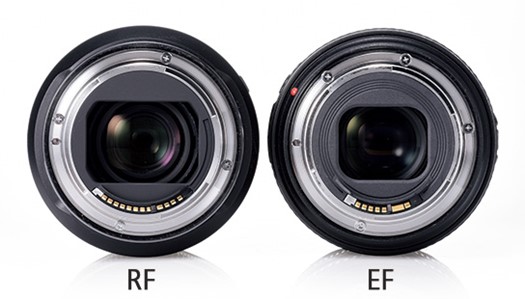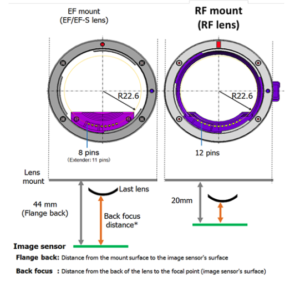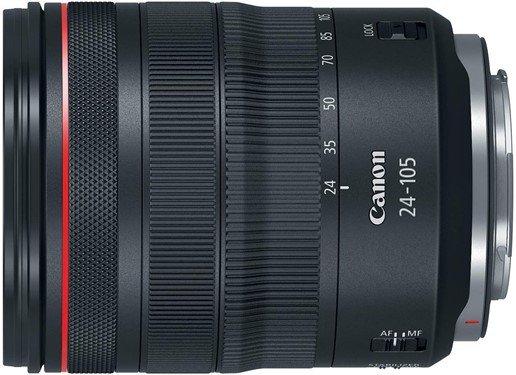Every camera needs a lens. A camera with an interchangeable lens needs a mount with an interface for mounting the lens and facilitating communication. The same is the minimum requirement in modern camera systems equipped with autofocus and electronic aperture control techniques. The question now arises –why must a photographer focus on the particular technologies used by their camera lens mount and lenses? Well, the performance of the lens and its mount prominently influences the image quality provided by a camera system.
Also Read: Best Canon RF Lenses RF Mount for EOS R Full Frame Mirrorless Camera
There is a reason why Canon created the RF mount in the R-series cameras. After 30 years of inception of the EOS cameras and their connected EF (Electronic Focusing) lens mount, the brand persists in presenting the latest high-end EF lenses. Moreover, Canon intends to release more EF lenses in the future. But, during the last 3 decades, there have been considerable technological advancements. Principally, computer-driven improvements are seen to influence the lens/camera design. Also, the corresponding upgrades are accessible for in-camera processing.
Limitations of the current EOS EF systems:
Assessing the current EOS system in the context of future reflections exposes some limitations as follows:
1. Insufficient extensibility in mount diameter and back focus distance to support all of
the increasingly assorted requirements in zoom and prime lenses
2. Limited rate of the electronic communication between lens and camera
3. Inadequate electronic channels between lens and camera to accommodate new operational ambitions
4. Restrictions in sensor-based AF operational capabilities
Collectively, these remunerations make a compelling argument for a more encompassing method to the interchangeable lens-camera system going forward. A new lens system is pivotal to form a foundation core to the new EOS R system.

One among such innovative technologies is the fast imaging autofocus that works based on the sensor. Looking at the performance of the Dual Pixel CMOS AF system from Canon which uses an AF-based dual-photodiode structure. This kind of structure is found in every photosite. Consequently, it provides 87 selectable positions (horizontally) covering 88% of the image width and 65 selectable positions (vertically) that cover 100% of the image height. These positions are found for max—5,655 manually selectable AF points. The DIGIC processors (version 8) are implemented in the introductory EOS R cameras.
The corresponding performance is so enhanced that it is possible to eliminate the conventional mirror assembly and the relevant AF system. Also, it is possible to discard the mirror assembly. The TTL (Through the Lens) optical viewfinder is now not practical, so that it can be substituted by EVF (Electronic Viewfinder). The Electronic vs. Optical Viewfinder Comparison is available here. However, keep in mind that with the elimination of mirror assembly, the lens mount can be shifted closer to the imaging sensor. Practically, this change shows excellent benefits.
The RF mount comes with the full-frame implementation of cutting-edge technologies from Canon. Essentially, the RF lens mount maintains the huge 54 mm inner diameter benefit of the EF mount. To understand this, for example, the Nikon Z mount has an identical 55mm diameter, whereas the Nikon F-mount diameter is just 44mm, and that of the Sony E mount is 46.1mm.
There is the preservation of durability, and the ultra-wide aperture supports the big diameter mount. Moreover, there is the reduction of the flange back distance (distance from the imaging sensor to the rear of the lens mount) from 44 mm to 20 mm. Therefore, there is support for the latest optical designs that are smaller and usually contain rear-positioned components with large diameters.
The more extensive rear-element optical design, which is now implemented, showcases decreased angle of light rays within the image circle edge. The twisting of light to a lesser inclination leads to enhanced image quality, chiefly with improved corrected aberrations. The more extensive rear-element design of the RF lenses leads to a decent weight balance and comfy shape.
The vital component of the RF mount design is the enhanced communication. The latest microprocessor is implemented in the lens. Along with that, the RF mount employs a 12-pin connection between the lens and the camera. There is a 50% increment compared to the 8 pins present on the EF mount. In addition to more data channels, this novel design offers higher data transfer speed for outstandingly fast AF, optimization of image quality, and improved image stabilization.
How the RF mount design contributed to enhanced image stabilization performance? The Canon USA White Paper has an answer to this question. According to that, inside a lens, a dual gyro sensor system senses any unintentional physical movements. The corresponding data is passed over the lens-camera communication to DIGIC 8 processor. Simultaneously, the image sensor observes any blur resultant due to these movements. This sensor also gives this image data to the DIGIC 8 processor. Subsequently, the two data reports are analytically processed at extremely high speed. Furthermore, a compensation control signal is produced and reverted faster to the lens for triggering the IS optical element, which neutralizes the disturbance.
The lens-camera communication data is too used for the in-camera DLO (Digital Lens Optimizer) function. The enhanced built-in memory capacity leads to more data. The same includes the storage of aberration correction data in-lens for accurate image correction. (However, we usually prefer zero corrections.) Keep in mind that DLO data from the compatible EF and EF-S lenses are saved in advance in the EOS R-series cameras.
RF 24-105 f/4L IS | EF 24-105 f/4L IS II:
A crucial requirement related to Canon’s engineers’ RF mount design was nothing but the EF lenses should be supported. The EF lenses are designed for a more extensive flange back distance. These lenses should be moved forward by 24 mm to work effectively.
The optic-less Canon Mount Adapter EF-EOS R, found in a wide range of designs extending from affordable and straightforward to options supporting drop-in filters or control rings, provides one crucial function. This function converts the EF 8-pin communications to the latest 12-pin design without any compromises in performance.
(Note: It is possible to add a tiny circular polarizer filter to a Canon TS-E 17mm f/4L Tilt-Shift Lens or Canon EF 11-24mm f/4L USM Lens.
Among native mount and adapter, the use of an adapter is not preferable. However, the benefits of the relatively shorter flange-back distance justified the reason to use the adapter. The lenses like EF, EF-S, TS-E, and MP-E that support the RF mount works excellently. They facilitate the inclusion of an RF-mount camera into a prevailing Canon kit.
Though the EF-S lenses are not most advantageous for the full-frame cameras, these lenses are accepted by the adapter. Furthermore, the R-series cameras automatically transit to crop mode due to the use of the adapter.
The EF-M series is devoid of the supported lens. Equipped with a shorter flange-back distance of 2 mm, the 18mm vs. 20mm is a direct challenge for EF-M to RF adapter design. Moreover, it seems implausible that we would perceive the availability of this kind of adapter.
The use of RF mount abilities leads to the inclusion of a latched control ring over RF lenses. The ring can be programmed for controlling Tv, Av, ISO, or +/- EV, and few more options to be added in the future. The corresponding programming is facilitated with/without the need for shutter release half-press. Besides, the adjustment direction can be upturned. Though the control ring comes clicked from the factory, the Canon Service could discard the clicking system. Initially, I find it confusing between the manual focus ring and the control ring. However, a bit of physical training solves this concern. Moreover, this feature improves speed in the field.
The RF mount utilizes a 3-tab bayonet design, similar to the EF mount. Though these two designs are identical, the tabs are aligned such that lenses cannot be unintentionally set up on non-compatible cameras.
In addition to the latest lens mount (rear), the RF caps and camera body caps naturally feature a more chic appearance than the earlier EF models. Both the RF mount caps are a tad broader than the relevant EF caps. The lens mount cap receives the more considerable upgrade, and it showcases a sturdy double-wall design. The frustrating aspect is that the RF rear lens mount caps mount in just a single orientation, unlike the 3 mounting options provided by the EF caps. Thus, they need extra care during installation.
The camera body caps and RF lens mount are compatible with the EF models. However, the RF bayonet mount tab positions lay restrictions on mounting the EF lens mount caps and EF camera body on RF lenses and R-Series cameras. When shifting to the RF lens system, remember to add some auxiliary body and lens mount caps into the kit.
As shown above, the RF front lens caps, in addition to a pair of RF lens mount caps, stay unaltered from the existing EF front caps. These EF front caps were effectively revamped before some time.
RF lenses make use of the electronic manual focusing. The focusing optic is not physically attached to the focus ring. But when it turns, the lens is triggered to vary the focus distance. This adjustment is made through a small, fast, and quiet motor.
Frequently, electronic manual focus lenses employ an adjustable speed focus drive. When you slowly turn the lens, the focus distances vary slowly. This is perfect for accurate focusing even at close distances. To make long focus distance alterations, turn the ring quickly. When implemented correctly, an adjustable speed focus ring offers benefits. But, I feel them quite annoying. Hence, I got more thrilled when I found out the R-series menu option for choosing among the fixed and adjustable speed manual focusing rates.
One more helpful menu option is the capability to vary the direction of the MF ring. As mentioned earlier, the control ring too comes with this option.
At least those RF lenses which were initially launched are without the focus distance windows. I considered that we would probably observe an LED panel like the one equipped on the Canon EF 70-300mm f/4-5.6 IS II USM Lens. I did not perceive the 70-300’s panel to be so valuable, and in fact, Canon concluded the same. But, the R-series cameras can depict the focus distance within the viewfinder.
R-series cameras come with a “Retract lens on power off” feature. This feature is default enabled. When you disable this feature, it prevents the meticulously selected focus distance from resetting while the camera automatically turns off.
An appealing RF design functionality is the lens mount’s external diameter that matches with the camera mount. In addition to a visually appealing look, the design streamlines the alignment of the lenses with cameras. Moreover, some finger space is given.
When the R-series cameras power off, the aperture blades of the mounted lens closes at a farther distance than the minimum aperture opening of the lens. Consequently, it protects the imaging sensor and shutter blades from harmful light, chiefly from the sun.
A good question is why this lens series entitled RF? One of the guesses I come across from a Canon rep is that the camera was entitled “R” and earlier, there were “EF” lenses. This explanation seems logical; however, it is just a guess.
Together with the initial EOS R-series camera, Canon presented 4 RF lenses. The 3 out of the 4 lenses come with f/2 or broader apertures (including Canon RF 28-70mm f/2L USM Lens). Moreover, those 3 of the 4 lenses are high-end models from L Series. This depicts that Canon is determined regarding this mount. The experience of min with the RF lenses and R-series camera was positive. Indeed, the new lenses with more features are on the way.
Development usually needs a positive change. Although it occasionally comes with troubles, the results are fantastic. In this case, the situation is comparatively modest. Apart from the expense of purchasing an R-series camera, the most significant trouble I feel is that an adapter is needed to upkeep the EF, EF-S, MP-E, and TS-E lens functionality. I will be glad that the adapter will come with new techniques.
To Summerize
According to Canon USA White Paper, the latest RF system design foresees constant innovations in lenses and also in future cameras. Canon has not revealed its next plan for the RF lenses. However, Canon’s designers are thrilled regarding the prospects and freedom provided by the latest RF lens mount. I am confident that we do not still perceive all its benefits, but the future will bring some great features and services.



